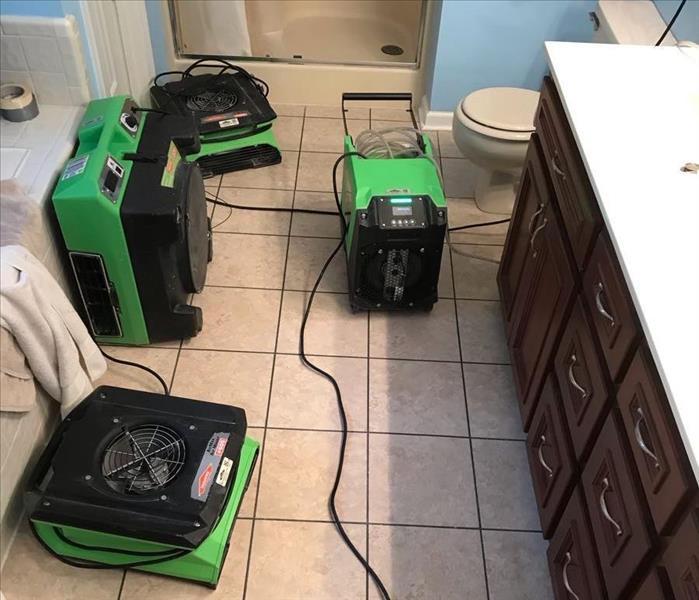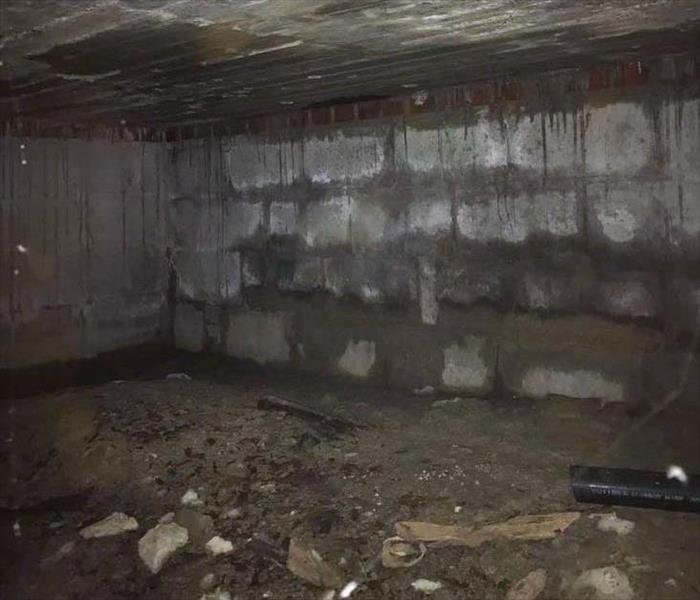Archived Water Damage Blog Posts
Emergency Kits: Must-Have Items for Water Damage Situations
10/16/2024 (Permalink)
 At SERVPRO, we’re here to assist you with comprehensive water damage restoration services.
At SERVPRO, we’re here to assist you with comprehensive water damage restoration services.
When water damage strikes, having an emergency kit ready can make all the difference in how quickly and efficiently you can respond to the situation. At SERVPRO®, we understand the urgency that comes with water damage, and we recommend preparing a kit with essential items to help you manage the initial impact of water intrusion.
Essential Items for Immediate Response
One of the first things you'll need in a water damage emergency is a set of tools to help you minimize the damage while waiting for professional assistance. A sturdy, waterproof flashlight with extra batteries is essential, especially if the power goes out or if you need to navigate through dark, waterlogged areas. Additionally, a basic tool kit with items like a utility knife, adjustable wrench, and screwdrivers can help you quickly shut off water valves, remove soaked materials, or perform other necessary tasks.
Waterproof gloves and boots should also be included in your kit. These will protect your hands and feet from exposure to contaminated water and allow you to safely move through affected areas. Heavy-duty trash bags are another must-have, as they can be used to quickly gather and dispose of water-damaged items.
Protecting Important Documents and Valuables
In the chaos of a water damage event, it’s easy to overlook the importance of securing valuable documents and belongings. Your emergency kit should include waterproof containers or bags for storing important documents like insurance papers, identification, and property records. Having these items protected will not only preserve their integrity but also make the recovery process smoother when you’re ready to file insurance claims or assess the extent of the damage.
If you have irreplaceable valuables such as family heirlooms, photographs, or small electronics, consider adding protective cases or waterproof storage solutions to your kit. This extra step can save you from losing items of sentimental or monetary value.
Supplies for Temporary Repairs
While waiting for SERVPRO to arrive, it’s important to take steps to prevent further water damage. Your emergency kit should include materials for temporary repairs, such as tarps, duct tape, and plastic sheeting. These items can be used to cover leaks, windows, or any openings where water might be entering your home. Sandbags can also be useful for blocking water from entering through doors or low-lying areas.
Another key item is a portable wet/dry vacuum. This tool can help you remove standing water from small areas, preventing it from spreading and causing additional damage. Be sure to follow safety guidelines when using electrical equipment in wet conditions.
Being prepared with an emergency kit tailored for water damage situations can help you respond quickly and effectively when disaster strikes. By having the right tools, protective gear, and supplies on hand, you can take immediate action to mitigate damage and protect your property until professional help arrives. At SERVPRO, we’re here to assist you with comprehensive water damage restoration services, but a well-prepared emergency kit is your first line of defense.
Frozen Pipes and Water Damage: Prevention and Recovery
6/12/2024 (Permalink)
 In this blog, we will discuss steps you can take to prevent frozen pipes and how to recover from water damage caused by frozen pipes.
In this blog, we will discuss steps you can take to prevent frozen pipes and how to recover from water damage caused by frozen pipes.
Winter brings with it the risk of frozen pipes, which can lead to water damage if not addressed promptly. When water inside pipes freezes, it expands and puts pressure on the pipe walls, causing them to burst. Burst pipes can result in significant water damage to your home or business. In this blog, we will discuss steps you can take to prevent frozen pipes and how to recover from water damage caused by frozen pipes.
Prevention: Insulate and Protect Your Pipes
Preventing frozen pipes starts with proper insulation. Here are some steps to protect your pipes from freezing:
- Insulate Exposed Pipes: Insulate any exposed pipes in unheated areas of your home or business, such as basements, attics, crawlspaces, and garages. You can use foam pipe insulation sleeves or heat tape to provide a protective layer.
- Seal Cracks and Leaks: Inspect your property for any cracks or leaks in walls, floors, or foundations. Seal them with caulk or weather-stripping to prevent cold air from entering and affecting the pipes.
- Keep Interior Temperature Consistent: Maintain a consistent temperature throughout your property, especially during freezing temperatures. Set your thermostat to a minimum of 55 degrees Fahrenheit, even when you are away.
- Open Cabinet Doors: If you have pipes inside cabinets, especially those located near exterior walls, open the cabinet doors to allow warm air to circulate and reach the pipes.
Recovery: What to Do if Pipes Freeze and Burst
Despite your best preventative efforts, frozen pipes can still occur. If you experience frozen pipes and subsequent water damage, here's what you should do:
- Shut off Water Supply: As soon as you discover a burst pipe, locate the main water shut-off valve in your property and turn it off. This will prevent further water flow and minimize damage.
- Call SERVPRO® for Professional Water Remediation: Frozen pipes can cause extensive water damage, including damage to walls, floors, and belongings. Contact SERVPRO professionals who specialize in water damage restoration. They have the expertise and equipment to extract water, dry affected areas, and restore your property to its preloss condition.
- Document the Damage: Take photos or videos of the water damage and make a detailed list of affected items. This documentation will be helpful for insurance claims and the restoration process.
- Remove Excess Water: If it is safe to do so, remove any standing water to prevent further damage. You can use mops, towels, or a wet/dry vacuum.
- Do Not Forget About Mold Prevention: Even after the water is extracted and the affected areas are dried, there is still a risk of mold growth. SERVPRO professionals use specialized techniques to ensure proper drying and take preventive measures against mold.
In conclusion, preventing frozen pipes and addressing water damage promptly are vital during the winter months. By insulating and protecting your pipes and knowing what to do in the event of frozen pipes and subsequent water damage, you can minimize the impact on your home or business. Remember, if you experience water damage from frozen pipes, contact SERVPRO for professional water remediation services. Our experts will help you recover and restore your property efficiently and effectively.
Navigating Water Damage During Home Renovations
2/21/2024 (Permalink)
 Quick and effective responses to water-related issues not only protect your home but also ensure that your transformative renovations proceed smoothly
Quick and effective responses to water-related issues not only protect your home but also ensure that your transformative renovations proceed smoothly
Renovating your home is an exciting endeavor that can breathe new life into your living space. However, unexpected water damage during renovations can quickly turn excitement into stress. Whether you're updating the kitchen or expanding a room, it's crucial to be prepared for potential water-related challenges. In this blog, we'll explore proactive measures to handle water damage during renovations, ensuring a smoother and more resilient transformation.
Pre-Renovation Inspection
Before embarking on renovations, conduct a thorough inspection of your home, paying close attention to areas susceptible to water damage. Check for leaks, identify weak points, and assess the overall condition of plumbing and roofing systems.
During renovations, your home can be exposed to various elements, including the possibility of unexpected rain or water from construction activities. Invest in protective coverings such as tarps or plastic sheeting to shield vulnerable areas and prevent water infiltration.
Regular Monitoring
Consistent monitoring is essential throughout the renovation process. Keep a close eye on potential water sources, including plumbing connections, roofing, and areas where structural changes are taking place. Early detection allows for swift intervention before damage escalates.
Emergency Water Removal Equipment
Equip yourself with emergency water removal tools such as wet/dry vacuums or submersible pumps. In the event of water intrusion, these tools can help you swiftly extract excess water, minimizing the potential for widespread damage.
Flooring is particularly vulnerable during renovations. Use waterproof materials and coverings to shield floors from water exposure. This is especially crucial in areas like kitchens and bathrooms where water usage is high.
Maintain Good Ventilation
Adequate ventilation is essential to prevent moisture buildup, which can lead to mold growth. Ensure proper airflow throughout the renovation space by using fans and opening windows when possible.
Secure Construction Perimeters
Establish secure perimeters around construction zones to prevent water from infiltrating other areas of your home. Use barriers or temporary walls to contain the renovation space and minimize the impact of potential water leaks.
Professional Waterproofing
Consider professional waterproofing measures, especially in areas prone to water exposure, such as basements or bathrooms. This may involve applying waterproof sealants, installing drainage systems, or using water-resistant building materials.
Regular Communication with Contractors
Maintain open communication with your contractors throughout the renovation process. Discuss potential risks and establish a clear plan for addressing water-related issues promptly. Contractors can provide insights into preventive measures and collaborate on solutions.
Insurance Coverage Review
Before starting renovations, review your insurance coverage to ensure it adequately protects against water damage. Understand the terms and conditions of your policy, and consider adjusting coverage if needed.
In cases of significant water damage, enlist the services of professional restoration experts. They have the expertise and specialized equipment to handle extensive water damage, ensuring a thorough cleanup and restoration process.
Quick and effective responses to water-related issues not only protect your home but also ensure that your transformative renovations proceed smoothly.
How to Prepare Your Home for Flooding
6/21/2023 (Permalink)
 Prepare your home for flood damage with these easy steps!
Prepare your home for flood damage with these easy steps!
Flooding can be a devastating event that causes significant damage to homes and properties. As a homeowner, it is crucial to take proactive steps to prepare your home and minimize the risks associated with flooding. In this blog, we will provide you with essential tips on how to prepare your home for flooding, ensuring the safety of your family and the protection of your property.
Understand Your Risk
The first step in preparing your home for flooding is to understand your risk. Research and gather information about the flood history in your area, including the likelihood of river or coastal flooding, flash floods, or heavy rainfall events. This knowledge will help you assess the level of preparedness needed for your specific location.
Evaluate Your Home's Vulnerabilities
Conduct a thorough assessment of your home to identify potential vulnerabilities to flooding. Check the foundation for cracks or weaknesses and inspect the walls, windows, and doors for any areas where water could seep in. Ensure that your gutters and downspouts are clear of debris and functioning properly to prevent water buildup around your home.
Install Proper Drainage Systems
Installing proper drainage systems around your property is essential in redirecting water away from your home during a flood. Consider installing French drains, sump pumps, or a comprehensive gutter system to ensure effective water management. Additionally, make sure that the grading around your home slopes away from the foundation to prevent water pooling.
Seal Vulnerable Entry Points
Take measures to seal vulnerable entry points where water could enter your home. Use waterproof sealant or caulking to seal cracks in the foundation, walls, and windows. Install weatherstripping on doors to create a tight seal and prevent water infiltration.
Elevate Valuables and Utilities
In anticipation of flooding, elevate valuable belongings and utilities in your home. Move furniture, electronics, and important documents to higher ground or upper floors. Consider elevating your HVAC system, electrical panels, and appliances to minimize potential damage.
Create an Emergency Preparedness Kit
Prepare an emergency kit that includes essential supplies such as food, water, medications, flashlights, batteries, and a first aid kit. Store the kit in an easily accessible location, and ensure that all family members are aware of its contents and location.
Develop an Evacuation Plan
In the event of severe flooding, having a well-thought-out evacuation plan is crucial. Identify safe evacuation routes and establish a meeting point for family members. Stay informed about local emergency alerts and heed evacuation orders from authorities to ensure the safety of your family.
Preparing your home for flooding is an important responsibility as a homeowner. By understanding the risks, assessing vulnerabilities, and implementing preventive measures, you can minimize the impact of flooding on your property. Remember to stay informed, create a comprehensive emergency plan, and regularly review and update your flood preparedness strategies. Together, we can safeguard our homes and protect our loved ones from the devastating effects of flooding.
If your home has been affected by flooding or water damage, our team at SERVPRO of Johnston County South is here to help. Contact us for professional disaster restoration services and let us assist you in restoring your home to its pre-flood condition.

 24/7 Emergency Service
24/7 Emergency Service



